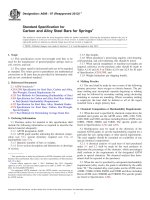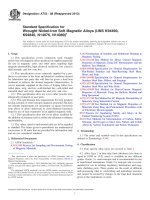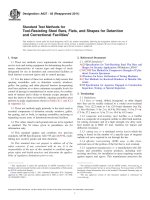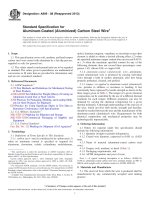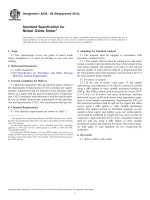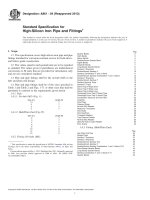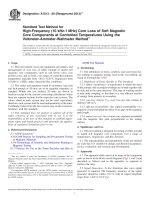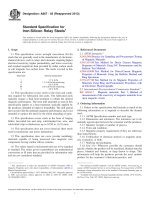Astm a 867 03 (2013)
Bạn đang xem bản rút gọn của tài liệu. Xem và tải ngay bản đầy đủ của tài liệu tại đây (85.56 KB, 4 trang )
Designation: A867 − 03 (Reapproved 2013)
Standard Specification for
Iron-Silicon Relay Steels1
This standard is issued under the fixed designation A867; the number immediately following the designation indicates the year of
original adoption or, in the case of revision, the year of last revision. A number in parentheses indicates the year of last reapproval. A
superscript epsilon (´) indicates an editorial change since the last revision or reapproval.
1. Scope
2. Referenced Documents
2.1 ASTM Standards:2
A34/A34M Practice for Sampling and Procurement Testing
of Magnetic Materials
A341/A341M Test Method for Direct Current Magnetic
Properties of Materials Using D-C Permeameters and the
Ballistic Test Methods
A596/A596M Test Method for Direct-Current Magnetic
Properties of Materials Using the Ballistic Method and
Ring Specimens
A773/A773M Test Method for dc Magnetic Properties of
Materials Using Ring and Permeameter Procedures with
dc Electronic Hysteresigraphs
2.2 International Electrotechnical Commission Standard:3
IEC 60404-7
Magnetic materials. Part 7: Method of
measurement of the coercivity of magnetic materials in an
open magnetic circuit
1.1 This specification covers wrought iron-silicon (Fe-Si)
steels that are generally used in the manufacture of electromechanical devices, such as relays and solenoids, requiring higher
electrical resistivity, higher permeability, and lower coercivity
and residual magnetism than provided by either carbon steels
or soft magnetic low-carbon irons. The steels covered in this
specification are:
Steel Type
Nominal Composition
1
1F
2
2F
3
1.1 % Si-Fe
1.1 % Si-Fe free machining
2.3 % Si-Fe
2.3 % Si-Fe free machining
4.0 % Si-Fe
1.2 This specification covers steels in the form and condition required for fabrication into parts. The fabricated parts
typically require a final heat treatment to obtain the desired
magnetic performance. The term mill annealed as used in this
specification applies to a heat treatment, typically applied by
the producer, intended to improve formability. The mill anneal
does not provide the optimum magnetic performance and is not
intended to replace the need for the finish annealing of parts.
3. Ordering Information
3.1 Orders to this specification shall include as much of the
following information as is required to describe the desired
steel:
3.1.1 ASTM Specification number and steel type,
3.1.2 Dimensions and tolerances. The tolerances are to be
mutually agreed upon between the consumer and the producer,
3.1.3 Quantity (weight or number of pieces),
3.1.4 Form and condition,
3.1.5 Magnetic property requirements if they are otherwise
than stated herein,
3.1.6 Certification of chemical analysis or magnetic property evaluation, or both,
3.1.7 Marking and packaging,
3.1.8 End Use—Whenever possible the consumer should
specify whether the product will be machined, blanked into flat
pieces, blanked and formed, or deep drawn to shape. This
information will help the producer provide the most suitable
product for the consumer’s fabrication practice, and
1.3 This specification covers steels in the form of forging
billets, hot-rolled bar and strip, cold-finished bar, wire, and
cold-rolled strip in thicknesses up to 0.250 in. (6.35 mm).
1.4 This specification does not cover electrical sheet steels
used in transformer and motor laminations.
1.5 This specification does not cover powder metallurgy
materials capable of being processed into magnetic core
components having similar silicon contents.
1.6 The values stated in inch-pound units are to be regarded
as standard. The values given in parentheses are mathematical
conversions to SI units that are provided for information only
and are not considered standard.
1
This specification is under the jurisdiction of ASTM Committee A06 on
Magnetic Properties and is the direct responsibility of Subcommittee A06.02 on
Material Specifications.
Current edition approved May 1, 2013. Published July 2013. Originally approved
in 1986. Last previous edition approved in 2008 as A867–03 (2008). DOI:
10.1520/A0867-03R13.
2
For referenced ASTM standards, visit the ASTM website, www.astm.org, or
contact ASTM Customer Service at For Annual Book of ASTM
Standards volume information, refer to the standard’s Document Summary page on
the ASTM website.
3
Available from American National Standards Institute (ANSI), 25 W. 43rd St.,
4th Floor, New York, NY 10036, .
Copyright © ASTM International, 100 Barr Harbor Drive, PO Box C700, West Conshohocken, PA 19428-2959. United States
1
A867 − 03 (2013)
before measurement of the coercive field strength, two different sets of requirements are necessary, one for ring and
permeameter testing and one for coercimeter testing.
3.1.9 Exceptions to this specification or special requirements.
4. Chemical Composition
6.2 Test Specimen Heat Treatment—The test specimen shall
be heat treated before testing as follows; heat at 845 6 10°C
for 4 h in a wet hydrogen atmosphere (dew point of − 20 to
5°C) then cool at a rate of 50 to 100°C/h to a temperature less
than 540°C followed by further cooling at any convenient rate.
For heat treatment of Type 3 steels, dry hydrogen (dew point
less than − 40°C) shall be used instead of wet hydrogen.
4.1 The chemical composition requirements are shown in
Table 1. Since magnetic and, possibly, mechanical properties
are of primary importance, variations in composition from
those shown in Table 1 are permitted by mutual agreement
between the consumer and the producer.
5. Form and Condition
6.3 Conventional dc Magnetic Testing:
6.3.1 Either ring or permeameter techniques may be used.
For ring specimens either Test Methods A596/A596M or
A773/A773M is permitted. For straight-length specimens,
either Test Methods A341/A341M or A773/A773M is permitted.
6.3.2 Whenever possible, test specimen size and shape shall
conform to Practice A34/A34M. The densities of these steels
for testing purposes are listed in Table X1.1.
6.3.3 Requirements—The coercive force requirements of
specimens heat treated in accordance with 6.2 are shown in
Table 2. The coercive field strength shall be measured from a
maximum flux density of 10.0 kG (1.00 T).
5.1 As the silicon content increases, cold working becomes
more difficult, hence, not all product forms are available in
each type of steel. The desired form and condition should be
specified and discussed with the producer to assure receiving
the appropriate product. Available forms and conditions are:
5.1.1 Forging Billet (all steel types)—Billet surface ground,
grit blasted, or acid cleaned.
5.1.2 Hot-Rolled Product (all steel types)—Hot rolled, hot
rolled and acid cleaned, and hot-rolled and mechanically
cleaned.
5.1.3 Cold-Finished Bars—Mill annealed, centerless ground
(all steel types), cold drawn (all grades up to 0.500 in. (12.7
mm) round), cold-processed shapes such as squares,
rectangles, hexagons (all types except Type 3), centerless
ground, and machine turned.
5.1.4 Strip (all types except Type 3)—As-supplied condition
must be specified as either cold rolled to hardness or mill
annealed. Steel can be supplied in coil form or as straightened
and cut to length flat product. Product can be supplied having
a rolled edge, either round or flat, or an edge produced by
slitting.
5.1.5 Wire (all types except Type 3)—Cold drawn, cold
drawn and mill annealed in either coils or straightened and cut
to length.
6.4 Coercimeter Testing:
6.4.1 Coercimeters are permitted provided it is demonstrated that flux density in the test specimen reaches at least 15
kG (1.5 T) during the magnetization cycle and that the test
method and test equipment satisfy the requirements of IEC
60404-7.
6.4.2 Requirements—The coercive field strength requirements of specimens heat treated in accordance with 6.2 and
tested using a coercimeter are shown in Table 3.
7. Packaging and Marking
6. Magnetic Property Requirements
7.1 Packaging shall be subject to agreement between the
consumer and the producer.
6.1 Under this specification, only the coercive field strength
(Hc) is required to be measured. This measurement can be done
either using ring or permeameter methods or by use of a
coercimeter. Since coercimeters saturate the test specimen
7.2 Material furnished under this specification shall be
identified by the name or symbol of the producer, by alloy type,
melt number, and material size. Each producer lot applied to a
order must be identified and packaged separately.
TABLE 1 Chemical Composition Requirements
Carbon
Manganese
Silicon
Phosphorus
Sulfur
Aluminum
IronA
A
8. Investigation of Claim
Type
1
Type
1F
Type
2
Type
2F
Type
3
0.04
max
0.50
max
1.10
nom
0.05
max
0.04
max
0.35
max
balance
0.04
max
0.50
max
1.10
nom
0.10/
0.22
0.04
max
0.35
max
balance
0.04
max
0.50
max
2.30
nom
0.05
max
0.04
max
0.50
max
balance
0.04
max
0.50
max
2.30
nom
0.10/
0.25
0.04
max
0.50
max
balance
0.04
max
0.50
max
4.00
nom
0.05
max
0.04
max
0.50
max
balance
8.1 Where any order fails to meet the requirements of this
specification, disposition of the material so designated shall be
subject to agreement between the consumer and the producer.
9. Keywords
9.1 coercive field strength; iron-silicon steel; relay steel
TABLE 2 DC Coercive Field Strength (Hc) Requirements
(Conventional Testing)
Oe
A/m
Iron is not analyzed nor is it reported.
2
Types 1 and 1F
Types 2 and 2F
Type 3
0.80 max
64 max
0.75 max
60 max
0.70 max
56 max
A867 − 03 (2013)
TABLE 3 DC Coercive Field Strength (Hc) Requirements
(Coercimeter Testing)
Types 1 and 1F
Types 2 and 2F
Type 3
1.2 max
96 max
1.1 max
88 max
1.0 max
80 max
Oe
A/m
APPENDIXES
(Nonmandatory Information)
X1. TYPICAL PHYSICAL, MECHANICAL, AND MAGNETIC PROPERTIES
X1.1 Typical physical, magnetic, and hardness properties of
the five types of steel are listed in Table X1.1, Table X1.2, and
Table X1.3, respectively. The data provided are for information
only and are not requirements in this specification.
TABLE X1.1 Typical Physical Properties
Density (g/cm3)
(kg/m3)
Electrical resistivity (µΩ-cm)
(Ω-m)
Saturation flux density (kG)
(T)
Curie temperature (°C)
Mean coefficient of expansion from 25
to 400°C (10−6/°C)
Types 1 and 1F
Types 2 and 2F
Type 3
7.75
7750
25
0.25 × 10−6
21.0
2.10
761
12.8
7.65
7650
40
0.40 × 10−6
20.6
2.06
748
13.2
7.60
7600
58
0.58 × 10−6
20.0
2.00
728
13.5
TABLE X1.2 Typical dc Magnetic Properties A
Maximum permeability
Coercive field strength (Oe)
(A/m)
Residual induction (kG)
(T)
Types 1 and 1F
Types 2 and 2F
Type 3
14 800
0.44
35
8.50
0.850
11 200
0.47
37
8.60
0.860
9000
0.49
39
7.00
0.700
A
Results from ring specimens heat treated in accordance with 6.2 and tested in accordance with Test Method A596/A596M. Permeameter test results for maximum
permeability and residual induction are significantly lower as a result of unavoidable loop shearing effects. Coercive field strength and residual induction are determined
from a maximum magnetic flux density of 10 000 G (1.00 T).
TABLE X1.3 Typical Annealed Rockwell Hardness
NOTE 1—Bar hardness determined at mid radius.
NOTE 2—Bar and strip that are straightened and cut to length exhibit slightly higher hardness than shown in this table.
Mill annealed
As heat treated for magnetic properties
Type 1
Type 1F
Types 2 and
2F
Type 3
60 HRB
50 HRB
75 HRB
70 HRB
90 HRB
88 HRB
100 HRB
95 HRB
3
A867 − 03 (2013)
X2. HEAT TREATMENT OF IRON-SILICON RELAY STEELS
X2.1 Heat treatment of parts made from iron-silicon relay
steels is necessary to obtain the best magnetic performance.
Magnetic behavior improves (that is, permeability increases
and coercive field strength decreases) when heat treating is
performed at temperatures as low as 700°C. For steel Types 2,
2F, and 3, further improvement in magnetic performance
occurs as the heat-treating temperature is increased. Steel
Types 1 and 1F will show a decline in magnetic performance
when heat treated above 870°C as a result of austenitization
and subsequent grain refinement upon cooling. Most
commonly, heat treatment is conducted at temperatures of
approximately 840°C for a minimum of 2 h followed by slow
cooling.
spheres such as hydrogen, forming gas (5 to 15 % hydrogennitrogen), and dissociated ammonia can be used. Vacuum heat
treatment can also be used.
X2.3 Further improvement in magnetic characteristics is
achievable by using a higher dew-point (−20 to 5°C) hydrogen
or forming gas atmosphere to promote decarburization.
However, the high dew-point atmospheres should not be used
(1) at temperatures in excess of 950°C, (2) when heat treating
steel Type 3, or (3) when the part, produced from any type, is
to be plated after heat treatment.
X2.4 Iron-silicon relay steels are very prone to rusting under
ordinary atmospheric conditions. A protective coating should
be applied to heat-treated parts as soon as possible. Chromium,
nickel, or cadmium plating is most commonly used.
X2.2 A protective nonoxidizing, noncarburizing, and nonnitriding atmosphere should be used. Low dew-point atmo-
ASTM International takes no position respecting the validity of any patent rights asserted in connection with any item mentioned
in this standard. Users of this standard are expressly advised that determination of the validity of any such patent rights, and the risk
of infringement of such rights, are entirely their own responsibility.
This standard is subject to revision at any time by the responsible technical committee and must be reviewed every five years and
if not revised, either reapproved or withdrawn. Your comments are invited either for revision of this standard or for additional standards
and should be addressed to ASTM International Headquarters. Your comments will receive careful consideration at a meeting of the
responsible technical committee, which you may attend. If you feel that your comments have not received a fair hearing you should
make your views known to the ASTM Committee on Standards, at the address shown below.
This standard is copyrighted by ASTM International, 100 Barr Harbor Drive, PO Box C700, West Conshohocken, PA 19428-2959,
United States. Individual reprints (single or multiple copies) of this standard may be obtained by contacting ASTM at the above
address or at 610-832-9585 (phone), 610-832-9555 (fax), or (e-mail); or through the ASTM website
(www.astm.org). Permission rights to photocopy the standard may also be secured from the ASTM website (www.astm.org/
COPYRIGHT/).
4

